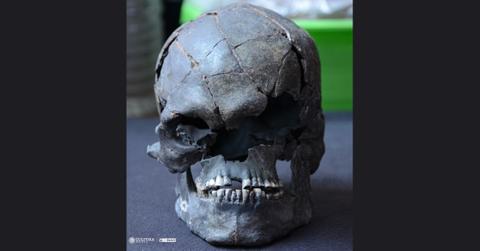Prehistoric Human Skeleton Dating Back 10,000 Years Discovered at Airport Construction Site in Mexico

Archaeologists have recently discovered what could be the oldest prehistoric human skeleton from the Valley of Mexico.
Archaeologists have recently discovered a prehistoric human skeleton in the Valley of Mexico, dating back at least 10,000 years, making it the oldest specimen from the region.
This discovery occurred during the construction of Felipe Ángeles International Airport, Knewz.com reported.
The prehistoric human remains, named "Yotzin" by archaeologists from the National Institute of Anthropology and History (INAH), translates to "unique" in Nahuatl, the language of the Aztecs.
According to an INAH press release, the remains are believed to belong to a hunter-gatherer male, aged between 25 to 30 years at the time of his death.
While carbon dating has yet to be performed, the skeleton's characteristics suggest it dates back to the late Pleistocene epoch, which spanned from around 2.5 million to 11,700 years ago, according to Britannica.
Anthropologist Arturo Talavera González conducted the initial study of the specimen in the Bioarchaeology Section of INAH's Directorate of Archaeological Salvage. He determined that "Yotzin" more closely resembles the first settlers of America or late Pleistocene hunter-gatherers than pre-Hispanic populations.
Notably, "Yotzin" stood about 5.74 feet tall, whereas pre-Hispanic remains typically measure between 5.25 and 5.41 feet in height.
González also observed that "Yotzin" had a robust skeleton with significant bone mass and severe wear on both the upper and lower jaws. He theorized that "Yotzin" did not consume carbohydrates, using his teeth as tools for working skins or fibers, evidenced by marked wear on the first molars and canines.
- What Lies Beneath: NASA Scientist Believes Aliens May Have Found 'Perfect' Hiding Spot in Earth's Oceans
- Global Threat: Russia Insider Warns West of 'World War Using Nuclear Weapons' Amid Escalating Support for Ukraine
- Countdown to Disaster? Ex-NATO Official Warns Russia, Iran and China Could Wage WWIII in Just Years
"If an individual presents this wear and tear without cavities, it is [identified as belonging to the preceramic age], because it can be an indicator that the denture served as a cutting and crushing tool; that is to say, to soften skins and cut vegetable fibers," he added..
Osteometric analysis revealed several distinctive features: an elongated skull (dolicocrane), a wide jaw, rounded clusters, unflattened femurs, and transverse flattening of the tibia (platicnemia).
"Platicnemia is characteristic of primitive hunter-gatherer peoples and tended to decrease with sedentarization and agriculture," González explained.
Never miss a story — sign up for the Front Page Detectives newsletter. Be on the scene the moment news breaks.
The preliminary analysis also indicated that the late hunter-gatherer suffered from migraines, periostitis (inflammation of bone tissue), and an infectious process in the middle ear and frontal bone of the skull.
Regarding the age of the find, the press release noted that preliminary paleoenvironmental and stratigraphic studies — conducted by biologist Laura González Quintero and researchers from the INAH Laboratory and Academic Support Branch, Flores Díaz and Cázares Rodríguez — suggest the burial layer dates to the interglacial period, approximately 13,000 to 20,000 years ago. This makes "Yotzin" the oldest find of its kind from the Valley of Mexico.
Prior to this discovery, the oldest known prehistoric skeleton from the region was a 10,500-year-old skull found in Chimalhuacán, Mexico, in 1984.
Become a Front Page Detective
Sign up to receive breaking
Front Page Detectives
news and exclusive investigations.
